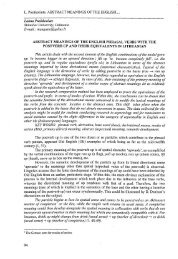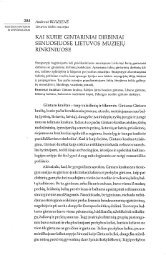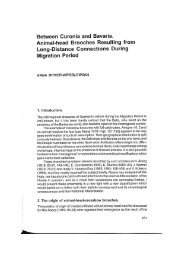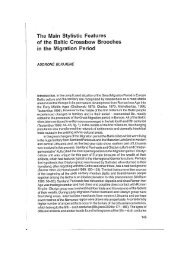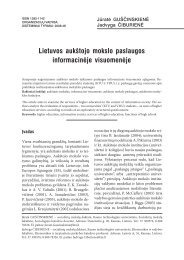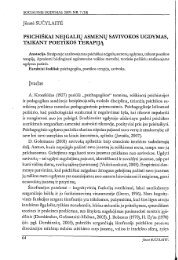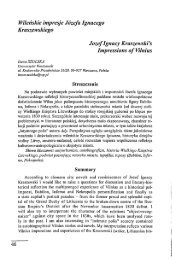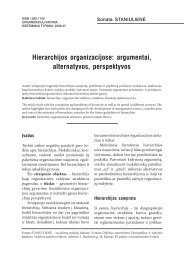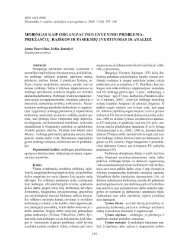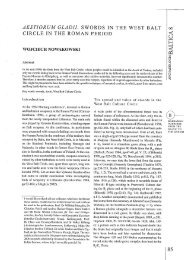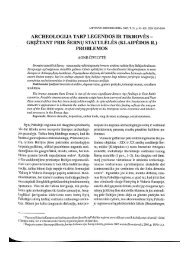ECO-MARKETING AND ECO-LABELLING: DOES IT ENSURE ...
ECO-MARKETING AND ECO-LABELLING: DOES IT ENSURE ...
ECO-MARKETING AND ECO-LABELLING: DOES IT ENSURE ...
You also want an ePaper? Increase the reach of your titles
YUMPU automatically turns print PDFs into web optimized ePapers that Google loves.
D.Grundey 156 ISSN 1648 - 4460<br />
Researcliing Customer Loyalty In Lithuania<br />
Symptoms of this trend are as follows:<br />
a care of a clean air, soil and water tanks,<br />
a protection of the nature against the devastation,<br />
a rational turnover and use of natural resources; a stress on the significance of<br />
recycling,<br />
an aspiration for minimization of the use of natural raw materials; a growing interest<br />
in the use of production wastes in producing new products,<br />
a popularization of ecological orientation and of healthy style of life,<br />
an awareness of interdependencies within a chain: environment - hunger -<br />
overpopulation.<br />
The following consequences of this trend can appear for marketing:<br />
• a better knowledge on consumer priorities,<br />
. the natural environment as a criterion in processes of product decisions,<br />
• a firm's orientation towards the environment,<br />
a domination of ecological and energy-saving products,<br />
the natural environment as an integral part of all fields of the firm's activity,<br />
• an impact on assessment criteria of brand-name products.<br />
On the basis of this, an idea of a new (ecological) marketing is being developed (e.g.<br />
Bergen, 1990; Castenow, 1993; Graczyk, 1999). Shortly speaking, modem marketing is such<br />
a way of thinking which should take into consideration, among other things, that:<br />
• firstly, a post-consumption phase is equally important for a product user like a<br />
purchase phase,<br />
• secondly, the natural environment is a kind of public good,<br />
• thirdly, there exist close inter-relations between a marketing orientation and<br />
an environmental orientation.<br />
A model of an 'ecological' marketing-mix should, of course, contain all 4P's:<br />
1. A producer should offer ecological products which not only must not contaminate the<br />
environment but should protect it and even liquidate existing environmental damages,<br />
2. Prices for such products may be a httle higher,<br />
3. A distribution logistics is of crucial importance; here I mean mainly ecological<br />
packaging.<br />
4. A communication with the market should put stress on environmental aspects,<br />
for instance:<br />
• a possessed CP certificate or ISO 14000 may be publicized to improve a firm's<br />
image,<br />
• the fact that a company spends expenditures on the environment protection<br />
should be advertised,<br />
• sponsoring of the natural environment is also very important,<br />
• ecological products will probably require special sales promotions.<br />
The level of greening-strategic, quasi-strategic, or tactical- dictates exactly what<br />
activities should be under-taken {Table I). Strategic greening in one area may or may not be<br />
leveraged effectively in others. A firm could make substantial changes in production<br />
processes but opt not to leverage them by positioning itself as an environmental leader. So<br />
although strategic greening is not necessarily strategically integrated into all marketing<br />
activities, it is nevertheless strategic in the product area.<br />
Alternatively, tactical greening in promotions might involve minimal, if any, greening<br />
of other areas; rather, it might be used simply to exploit a short-term opportunity. A company<br />
might simply choose to sponsor a local environmental program without modifying its other<br />
activities. This may seem to be an "effective" strategy from a broader business perspective,<br />
but not necessarily from a green marketing perspective, especially if the firm is seeking to<br />
ni/lNSl-OmtATlONS IN liUSINHSS & UCONOMICS, Vol. 8, No 1 (16), 2009



